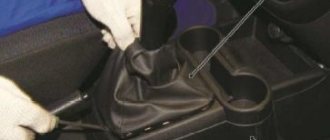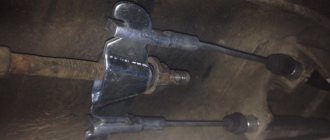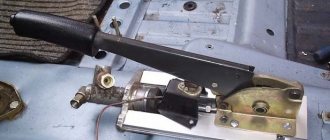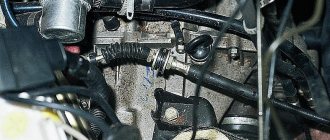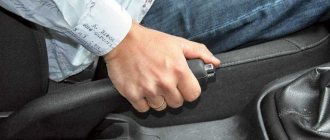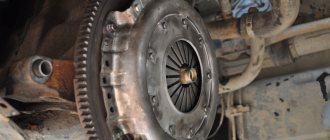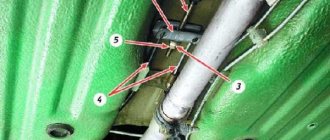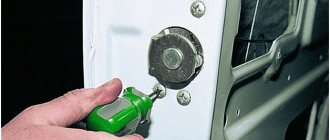The parking brake, or as it is popularly called the “handbrake,” although it is intended to immobilize the car while parking, not all drivers and do not always use it. If the car has an automatic transmission, then, by and large, a handbrake is not needed at all, but owners of cars with manual transmission, as a rule, prefer to leave the car in first gear when parking. This is due to one of the most important reasons - harsh winter conditions and poor road quality may not allow the handbrake to operate when necessary. This may be caused by icing on the pads or clogged pads. But first things first.
How does the handbrake system work?
Applying the parking brake activates the rear brakes and ensures that the vehicle does not roll, even on a relatively steep incline. However, if the handbrake does not hold the vehicle, there is a problem that must be corrected to ensure the safety of the driver and others.
Parking brake systems vary greatly from one automaker to another and even between different makes and models of cars. In general, they are divided according to the type of brakes and the method of their use.
It is immediately necessary to understand that in the vast majority of cases in passenger cars, parking brakes use the rear wheels and are divided into two types:
- drum - consisting of two semicircular blocks that are located inside a cylindrical drum. If, on one side, they are rigidly fixed, then on the other there is a special piston mechanism that forces the pads to move when using the handbrake;
- disc brakes - consisting of a special brake disc mounted on the car axle and two pads. When you use the handbrake, the pads compress and prevent the car from moving.
The car's braking system can also be mechanical or hydraulic. If in the first option, braking is carried out using a system of cables and the force of a person who puts pressure on the handbrake, then a special piston is used in hydraulics.
Important! Depending on the type of braking system, the reasons why the handbrake does not hold may vary significantly.
Replacing the handbrake and front parking brake cable on a VAZ 2101-VAZ 2107
Welcome! There are two cables in total in the car, namely the rear and front handbrake cables. The front one, coming from the parking brake and having a short length. It goes to the rear, compared to the front cable it is very long. The rear one goes directly to the two rear wheels. Thanks to the cable system, the car is braked.
Note! You will have to remove the handbrake, which means the following tools will be useful: various kinds of wrenches, a screwdriver and pliers.
Part location
It comes from the handbrake and passes under the bottom of the car, connecting to the rear (main) cable. Below we have attached a photo with a diagram of the handbrake. The front cable is indicated by number 2.
Note! In the diagram above it may seem that cable number two is divided into two parts, but in fact it is not. It is solid, just in the place where it supposedly breaks (in the diagram) there is a roller (indicated by number 8).
When to change the cable and the handbrake itself?
You have to change it when the cable breaks. You will feel this when the handbrake begins to rise very easily and to a very high position, almost to a vertical position. Exactly the same situation will arise if the cable breaks at the back. Therefore, before you go to a car store and buy a new one, inspect the bottom of the car and figure out which cable has become unusable.
Note! The cable tends to stretch over time. It all depends on the quality of the material; a high-quality cable will last longer and stretch to a shorter length. If you see that this cable is sagging and the adjustment does not lead to anything good, then you will have to replace it with a new one!
Now let's talk about when to change the handbrake itself. Firstly, there is a gear sector on the parking brake, thanks to which the handbrake rises up neatly and does not slip between clicks. Secondly, the so-called pawl, which blocks the handbrake after lifting up, its breakdown leads to the handbrake not being held in one position, it will constantly fall. These factors are a reason to replace the part with a new one.
How does the handbrake work?
When the driver activates the handbrake, either by pulling the handle between the front seats (3) or by pressing the parking brake pedal under the dashboard, a cable (12) running to the rear of the car is pulled, applying tension to the brake pads. When the driver lowers the handle, the return spring (11) helps return the brake system to its normal configuration.
The system itself is quite simple and banal - the parking brake handle is connected to a cable in a special plastic sheath, in which it can move freely. This cable goes to the adjusting bolt, which can be loosened or tightened. Then it splits into two cables that go to the brakes on the rear wheels.
In simple words, by activating the handbrake, the cable tightens and brings the pads together, which then secure the car.
Replacing the handbrake and front cable on a VAZ 2101-VAZ 2107
Removal
Remove the guide from the tip of our cable, for more details see the article: “Replacing the rear cable”, points 3-4.
Take a wrench and remove the bolt securing the roller to the bracket (the bracket is indicated by the blue arrow). Carefully remove the roller by rolling the roller towards the tip of the front cable, as shown in the figure, and remove it from the car.
Note! Be careful: inside the roller there is a bushing (number 3 in the photo below) and a fastening bolt (number 1). Don't let the parts fall and get lost.
We recommend using Litol-24 or LSC-15 lubricant, lubricating the contacting surfaces of the bushing itself (the surface is indicated by the letter B) and the surface of the roller (the letter A). To do this, remove the bushing from the socket.
Now pull the cable to the bottom and remove the cable from the bracket and the intermediate support of the cardan drive (indicated by the blue arrow).
Get out from under the bottom of the car and move into the interior. While inside the car, remove the two screws securing the handbrake trim, remove it and set it aside.
You will see four handbrake mounting bolts. By unscrewing them, you will remove the handbrake from the car along with the attached cable (front).
Note! If necessary, disconnect the cable from the handbrake: using pliers, remove the small cotter pin (looks like a small twisted wire inserted into the hole; a washer is placed under it, holding the parts in place) that goes into the hole indicated by the red arrow. Unfortunately, the hole is hard to see in the photo, but it is present in the so-called finger, where the cable tip is installed. Remove the cotter pin securing the end of the cable and remove the washer with the cable as shown in the figure below.
Causes of malfunction and their elimination
As a rule, the reasons why the handbrake does not work are quite simple and do not require long or expensive repairs:
- torn cable . One of the common causes is a broken cable on the handbrake or under the car. The problem is solved by simply replacing the cable;
- jammed cable . Due to damage to the sheath in which the cable moves, it may become jammed, preventing you from using the handbrake. And the cable itself consists of many steel strands, which, if damaged, can also prevent proper operation. The solution is to replace the cable;
- dirty brakes . If dust, dirt, ice or reagents that are sprinkled on roads in winter get on the pads, this can cause the brakes to not work properly. The solution is to press the brake pedal several times smoothly while the car is moving. Thanks to friction, the pads will be cleaned;
- incorrect adjustment . It may happen that the cable system is not adjusted properly, the bolt is not tightened correctly, or the length of the cables is incorrectly selected. The solution is to adjust the system and correct tension of the cables;
- pad wear . The pads are subject to abrasion during operation. Every time you apply the brakes, the pads gradually become unusable. The solution is to replace the pads;
- oil in the pads . Oil or brake fluid leaks can cause the car to not hold up with the handbrake. The most important thing in this case is to identify the cause of the leak - it could be the rear axle seal or the brake cylinder. The solution is to eliminate the leak and clean the pads. If the pads are very oily, replace them.
Replacing the rear parking brake cable on a VAZ 2101-VAZ 2107
Welcome! The rear handbrake cable - not all people know, but the parking brake drive consists of two two cables, namely the front and the main rear cable, over time the rear cable becomes unusable, that is, it stretches, breaks, etc., so In this case, you have to change it to a new one, because leaving a car anywhere without a handbrake can be scary, bad thoughts immediately pop into your head that the car will roll, etc., which is why you need to change the cable immediately after it fails.
Summary:
Note! In order to replace the rear parking brake cable, stock up on: A basic set of wrenches that will contain all the necessary keys for replacement, as well as pliers, or you can also use pliers instead!
Where is the rear handbrake cable located? Let’s say right away that in this article we will not describe exactly where the rear cable is, because in another article (Previously) on our website we already explained in detail the location of both handbrake cables, and the location of the rear one was even indicated with arrows in the photo that was taken on car VAZ 2107 from under the car, you can find out more about this article and the location of the cable itself by clicking on this link (the link leads to our website).
When should you replace the rear parking brake cable? It is changed if it is severely damaged and therefore cannot function normally (problems will occur with the handbrake if the cable is not working correctly, it will either not work, or it will be difficult to lift, or whatever the case may be).
How can the cable get damaged, you ask? Let's break this down a little! Firstly, over time, any cable (Depending on the quality of workmanship) is stretched, if the cable is branded and made from high-quality materials, then it will take longer to stretch than the one that will be bought, for example, on the market, and in addition to stretching, the cable may break ( It breaks only due to heavy loads on it, or if it was made from low-quality material) after it breaks, you will immediately understand it, because the handbrake will rise up very easily and will not really hold the car.
Note! There is something else, over time, as you know, any part rusts and begins to seem to stick to the one that is standing next to it, now I will explain how this is so! The rear cable itself, as you already understand, goes to both rear wheels, in the place where it comes close to the wheels you will no longer see the cable (the cable is indicated by a red arrow) but you will only see its shell, which is indicated by a blue arrow, so that’s when you don’t use the cable for a long time it rusts and becomes unusable and thereby sticks together with this braid, so to speak, in connection with this, the mobility of the cable becomes much worse (It is very easy to check the cable for mobility, to do this, just pull the cable itself, which is indicated by the red arrow, and if it is It’s easy to move, then everything is fine with it) and thus it must be replaced!
Diagnostics
What to do if you couldn’t identify the reasons yourself? In this case, you should contact a car service center, where a mechanic will carefully inspect the entire system. To do this, you may need to remove the rear wheels and check the drums. In any case, handbrake breakdowns do not require expensive repairs, since important components and assemblies in the braking system are not involved.
It is important to know how many clicks the handbrake should have. The golden rule of auto mechanics is THREE clicks, then the parking braking system is considered working.
↑ How to remove the handbrake of a VAZ 2106
We work on an inspection ditch or on a lift.
To replace the rear parking brake cable, hang up and remove the rear wheels (preferably at the same time).
- Lower the parking brake lever to its lowest position.
- Using pliers, disconnect the spring from the front (short) cable.
- Using two “13” wrenches, loosen the tightening of the adjusting and locking nuts and unscrew them, holding the tip of the front cable with pliers.
- We remove the equalizer.
- Remove the brake drum and shoe from its support.
- Disconnect the cable end from the lever.
- Using an “8” wrench, unscrew the two bolts securing the cable to the brake shield and remove the cable from the shield.
- Using a 10mm wrench, unscrew the two nuts securing the cable bracket to the body and, removing the bracket, release the cable.
- We disconnect the tip of the cable sheath from the bracket by sliding it back and down.
- Similarly, remove the second branch of the rear parking brake cable.
- To replace only the front parking brake cable, perform the work shown in photos 1–4.
- Inside, use a Phillips screwdriver to unscrew the self-tapping screw securing the protective casing.
- For convenience, it is advisable to remove the driver's seat.
- We remove the casing.
Design Features
If a motorist wants to independently figure out how to make a handbrake on a VAZ-2106, he must remember many certain design features. In particular, the right branch (from the machine side) of the cable is not the same as the left branch. The latter has a small rubber tube that is located between the front tip and the bushing.
To assemble the handbrake yourself, you need to know its design features.
To do everything correctly, you need to position the cable sheath so that it runs along the inner side of the limiter, grabbing the longitudinal rod of the rear suspension from below.
In addition, it is necessary to install the ends directly into the body brackets from different sides of the vehicle, and then attach the brackets themselves to the body.
The last tuning step should be to adjust the parking brake drive.
↑ Assembly of the VAZ-2106 hand brake
We assemble the parking brake system components in the reverse order of removal or disassembly, and check the drive adjustment.
Lower the lever all the way. Using an adjusting nut, we tighten the cable so that the full upward stroke of the lever with a force of 40 kgf is 2–4 teeth (“clicks”) along the sector.
When the lever is fully lowered, the wheels should rotate freely without jamming.
How to properly adjust the handbrake, video
One of the elements of the braking system of a car is the parking brake; in motorist circles it is called the handbrake. The mechanism is needed to ensure that the car remains in place while parked (especially on slopes). Every self-respecting motorist simply must know how to tighten the handbrake.
What is the importance of system health?
The serviceability of the parking lock is very important, like any other elements included in the list of the car’s braking system. Tasks that a well-functioning handbrake performs:
- Ensures that the machine stops on any uneven terrain (rises, slopes, etc.).
- Helps in situations where the main brake has failed or during emergency braking.
- Creates a controlled skid (requires certain skills).
- Can temporarily replace the main system (when it fails).
But remember - the use of such a mechanism instead of the main system is strictly prohibited, if only because it is not intended for this. As a last resort, when such use is still necessary, do not apply the handbrake too sharply, this can cause the car to skid, provoking a dangerous situation in which both you and other road users may suffer.
The handbrake consists of three main parts:
- Handbrake drive.
- Actuating mechanism.
- Control node.
The drive is a metal cable. It is this cable that activates the car’s brake pads or its stopping system (depending on the design features of the car). The part that transmits force to two cables is designed to evenly distribute the force between the wheels.
Sometimes the cable can become loose, which leads to a situation where the handbrake does not hold and needs to be tightened. As a result, the handbrake adjustment must be carried out jointly by the service station workers or with their own hands.
The actuator of the handbrake, which needs to be tightened, is the pads of the rear units, which are driven by both hand and foot drives. Thus, the design does not have to be very complicated.
Main causes of failure
The main reason why such an important device may break and need to be replaced is mechanical wear of the handbrake. As you know, the basis of the system is a small cable that transmits forces from the lever to the mechanism. It actually turns on this node.
The operating conditions of the cable are quite complex - the constant load from the force that the driver transmits through the handbrake lever to the system, sooner or later, can damage the device.
However, the cable breaks extremely rarely - most often, the cables simply jump off. Or the tips fixed in the drum are ground with very long wheel bolts. Needs renovation. Also, the parking brake may not work due to wear on the rear drum brakes (as well as abrasion of the pads, depending on the design).
As a result, the unit ceases to perform the functions assigned to it - the handbrake simply does not hold. The parking brake needs to be replaced and subsequently adjusted. But not everything is so simple - in some cases, the device can be damaged during emergency braking of the car - as a result, it will require repair or replacement.
Often the metal is not completely ground, but the steel fibers are stretched and moving in the shell is very difficult. But it doesn’t matter what the reason for the parking brake failure is, why it doesn’t hold. The purpose of our article is to figure out how to solve the problem.
Rolling down a hill or replacing the handbrake cable on a VAZ 2109 and 2110 in a garage. The topic is quite relevant in view of the fact that the degree of fixation of the handbrake has always been of interest to every driver. Whatever one may say, this is an additional guarantee of safety both on the highway and in the parking lot. In some cases, emergency situations occur due to the fact that most drivers neglect the rules for using the handbrake, or deliberately bring it to a faulty state. Let's look at how to use it correctly and what is needed for this below.
Operating principle and replacement algorithm
Replacing the handbrake cable on a VAZ 2109 and 2110 can be done on your own within half an hour, unless of course you are lazy and go to a car service center for repairs. To do this we need the following equipment and tools:
Provided that we have all this ready, we can begin the repairs . So,
- It is necessary to have an overpass or inspection hole, since without them we will not be able to get under the bottom of the car;
For those who do not fully understand, the handbrake in all cars is located between the two front seats. It can be covered with various drawers - glove compartments, but this is not important. The main purpose is to fix the parking of a car without outside help, even when neutral is turned on and the road is downhill under the wheels, which is a ratio of no more than 1/4.
Reasons for adjusting the parking mechanism
The condition of the brakes should be checked once every 30,000 kilometers or monthly. If you suspect that something is wrong with the device, you can check the part more often, especially since there is nothing complicated in such a check, and it goes very quickly.
- You can drive up a steep hill and tighten the handbrake handle well. If the car doesn't start to roll after you release the main pedal, then everything is fine. If the car starts to move, try to tighten the handle more, is it the same? You can safely drive the car into the inspection pit and change consumable parts.
- There is another way to check functionality. Engage the first gear, pull up the handbrake handle and slowly, smoothly, start to move away; if the handbrake is working, nothing will work out for you, and the engine will simply stall. If the car moves, although it is slow, it means that the handbrake needs to be tightened, traffic safety is already at risk. To do this, again drive the car into the pit and inspect the system.
When to adjust the handbrake
Proper operation of the parking brake system ensures road safety and should therefore always function properly.
The handbrake needs to be tightened and adjusted when:
- linings or discs (drums) were changed;
- brake pads or linings were adjusted;
- The hand brake cable has been replaced;
- the control mechanism has been reinstalled;
- The free play of the parking mechanism handle has increased significantly.
To fix the system, you can go to a service station, but you can do it yourself, for this you need to know how to properly adjust the parking brake.
In principle, having a general understanding of the process, you can tighten the parking mechanism. The only thing you should remember before tightening the handbrake cable is that the entire process must be carried out in compliance with safety precautions and in the designated place. Otherwise, harm may occur to the person doing the repairs.
